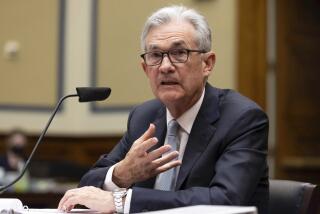Nine states face economic contraction, the most since 2009 crisis

- Share via
Nine states’ economies are expected to slide into contraction within six months — the most since the financial crisis ended more than a decade ago, according to the latest projections from the Federal Reserve Bank of Philadelphia.
West Virginia’s economy is forecast to shrink the most, while a decline in neighboring Pennsylvania is anticipated to be the most severe since May 2009 during the tail end of the Great Recession, figures released this week show. A faltering economic outlook in coming months would probably cast a shadow over President Trump’s reelection bid.
Delaware, Montana and Oklahoma are still expected to face shrinking economies in the next six months, as predicted in the analysis for the prior month. The list of states was expanded to include contractions on the horizon for Vermont, New Jersey, Kentucky and Connecticut. The bank no longer expects Alaska to post negative growth.
The forecast puts the number of states at risk of slipping into contraction at the highest since July 2009, the data show.
The overall outlook for the economy, which is enjoying the longest expansion on record, has been helped by the Trump administration scoring trade deals — including a pact with China due to be signed this month — lower interest rates, a tight labor market and a rally in stocks.
A Bloomberg Economics model to determine the United States’ recession odds estimates the chance of one within the next year at about 1 in 3 — though that’s down from last year.
At campaign rallies, Trump has cited his handling of the economy as a reason he should be reelected in November. Democratic candidates including Sens. Elizabeth Warren and Bernie Sanders have countered in debates that economic gains under Trump have primarily gone to corporations and the rich.
The early-primary states of Iowa and New Hampshire are expected to see marginal growth over the next few months, according to the Philadelphia Fed, which releases six-month leading indexes for the 50 states on a monthly basis.
The index predicts the six-month growth rate by analyzing state data including housing permits, initial unemployment insurance claims, delivery times from the Institute for Supply Management manufacturing survey, and the interest rate spread between the 10-year Treasury bond and the 3-month Treasury bill.
The local figures are more volatile than national data, and single events — such as hurricanes, plant shutdowns or temporary swings in demand for a particular product — can have outsize effects on state economies.
More to Read
Inside the business of entertainment
The Wide Shot brings you news, analysis and insights on everything from streaming wars to production — and what it all means for the future.
You may occasionally receive promotional content from the Los Angeles Times.










